Jim Porter Testifies Before Congress On Climate Crisis
Assessment of Global Biodiversity Loss
Testimony of
Dr. James W. Porter
Odum School of Ecology
University of Georgia
Athens, GA 20602
jporter@uga.edu
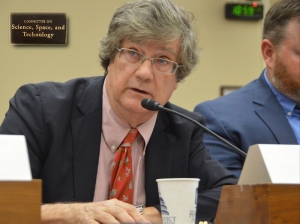
U.S. House of Representatives
Committee on Science, Space, & Technology
Tuesday, 4th of June, 2019

This hearing has been called to addresses the continuation of diverse life on Earth and the integrity of the life-support systems that diverse ecosystems provide to everyone. The current IPBES assessment suggests that of the estimated 8.7 million species on Earth, 1 million are facing extinction. In addition, the magnitude and pace of these extinctions is likely to accelerate unless we put in place sweeping and sustained actions to prevent these catastrophic losses.
In this testimony, I will show that the global losses detailed in the IPBES Report are already occurring on coral reefs. Further, I will present evidence demonstrating that the risks outlined in their assessment will, almost inevitably, increase for coral reefs in the very near future.
Although coral reefs are tropical shallow-water marine habitats and cover less than 1% of the planet, they have an outsized importance to both human beings and the natural world.

Coral reefs generate $9.9 trillion U.S.D. annually. A half billion people rely on them for their protein and as a source of income.
The following gives a thumbnail sketch of the importance of coral reefs to humankind:
- 94 of the world’s sovereign nations (roughly half of all countries) have coral reefs within their territorial boundaries.
- Most of these are developing countries desperately in need of the goods and services that coral reefs provide.
- 500 million people are dependent on coral reefs as their primary source of protein and income.
- Coral reefs generate $9.9 trillion U.S.D. / yr. (roughly the GDP of Switzerland).
- Coral reefs generate $29.8 billion/yr. in Hawaii and Florida.
- On the Great Barrier Reef, 90,000 full-time jobs are directly dependent on coral reefs.
- Coral reefs have proven to be a marine pharmacopeia, yielding new drugs that reduce the risk of heart attacks in older Americans, cure certain kinds of cancer, and that kill the A.I.D.S. virus more effectively than AZT.
In addition to their importance to human society, coral reefs are also of outsized importance to the history of life on Earth:
- Coral reefs are the oldest, most productive, and most biologically diverse of all marine communities.
- Coral reefs are the only living things that can be seen from outer space.
- 25% of all described marine species of plants and animals live exclusively on coral reefs.
- With increased taxonomic studies, that percentage would rise dramatically.
- However, with the predicted near-term extinction of coral reefs world-wide, we may never know that number precisely. In this respect, Dr. E.O. Wilson’s comment seems especially apropos:
Most species will probably be described from a single museum specimen, long after the species has gone extinct.
…………….. E.O. Wilson, Harvard University
- Coral reefs are the most productive of all marine communities, generating close to 2,000 dry grams-carbon / m2 / yr.
- Due to their biological diversity, especially at higher taxonomic levels, coral reefs are by far the most diverse environments on Earth. For instance, while tropical rainforests harbor only 8 animal phyla, coral reefs sport 30.
- Most importantly, recent studies of the history of life on Earth show that 85% of the time that a new Family, Order, Class, or Phylum appears on Earth, it does so first on coral reefs. This makes coral reefs both a Cradle of evolution for radically new life forms and a Museum for their ability to retain species that evolve there.
- The destruction of coral reefs therefore does not just threaten global species diversity, but also the fundamental ability of life to generate new life.
- A specific example of this comes from the marine sponges (Phylum Porifera). Class Sclerospongiae, one of the 5 classes of sponges. It has the unique ability to form its skeleton out of either limestone (calcium) or glass (silicone).
- This Class is exclusively shallow-water, tropical marine.
- Although the last Class of organisms (in any phylum) went extinct more than 500 million
years ago, with the destruction of coral reefs, we could lose this Class within the next 50 years.
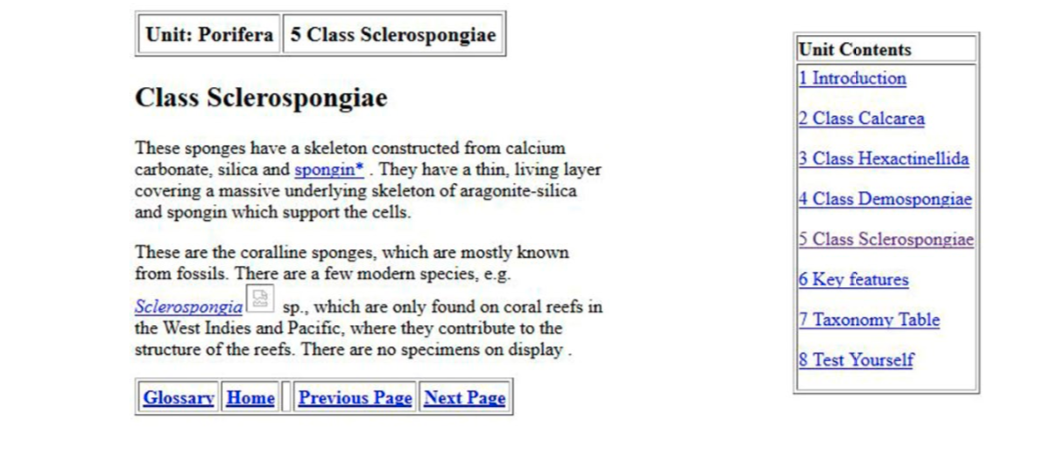
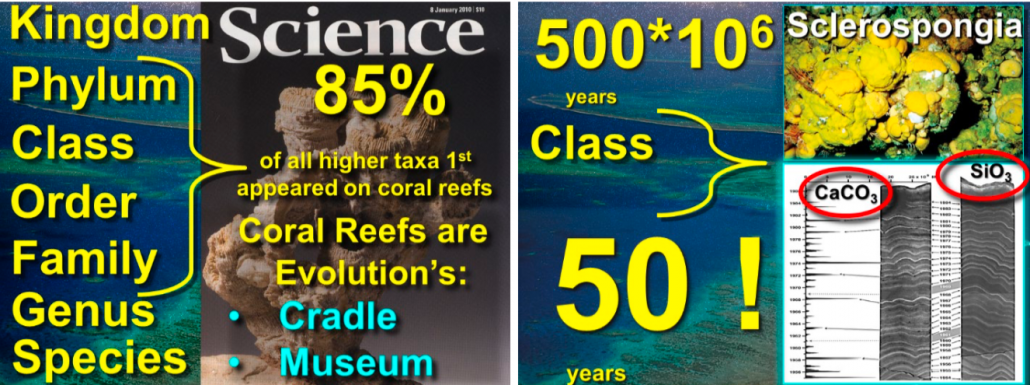
All of the factors listed by the IPBES as threats to the survival of terrestrial species world- wide also pertain, in varying degrees, to coral reef species.
- The destruction of coastal zone habitats (including mangroves and sea grass beds) occurs by rampant shore-line development.
- Overfishing on coral reefs, especially of large fish and top predators, such as sharks, occurs in many tropical countries.
- Pollution, both:
- Large and small plastic particles on beaches and in many central oceanic gyres.
- Coastal-zone eutrophication driven by waste-water from coastal communities and
nearby agricultural lands (especially fertilizer-intensive sugar cane fields). - Invasive species, such as the Indo-Pacific lion fish that were released into the tropical
waters of South Florida are now found everywhere throughout the Caribbean.
By far the biggest threat to coral reefs, however, comes not from these ancillary stressors, but from rising ocean temperatures. Corals already live close to their thermal tolerance limits. The addition of just 2 degrees C will kill them.

Due to burning fossil fuels (coal, oil, and natural gas), global temperatures are rising rapidly, especially in the oceans. The reason for this can be summarized as follows:
- 93% of the heat generated by green-house gases is “stored” in the ocean, not in the air.
- This is why water temperatures have risen so quickly.
- If it weren’t for the oceans’ ability to absorb greenhouse-gas generated global-warming,
the average temperature of our planet would be 122oF. - The oceans are ‘saving’ us (temporarily), but at an immediate cost to coral reefs.
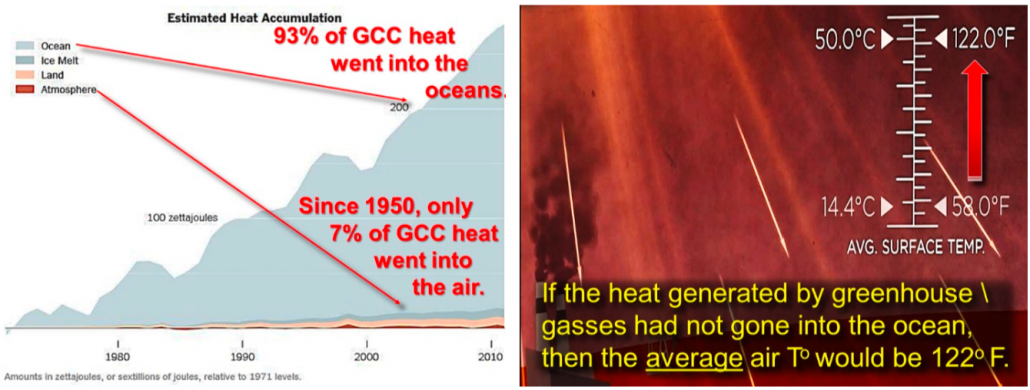
An irony is that these tropical organisms are much closer to the high temperatures that kill them than to the low temperatures that kill them. They are like orchids, you can cool them down a little and they will survive, but you cannot heat them up:
- In tropical waters, corals live within 2 degrees C of the high temperatures that kill them.
- Elevated temperatures cause corals to lose the symbiotic algae which live inside them.
- These symbionts photosynthesize and provide corals with food.
- When corals lose their symbiotic algae, they starve to death.
- These symbiotic algae also give corals their color (the colors of coral are from plant
pigments, not animal pigments). - When the algae die, you can see through the clear animal tissue to its white lime-stone
skeleton underneath, hence the term “coral bleaching.”
The irrefutable science behind these observations demonstrates that:
- Global warming will cause tropical seas to rise above this 2 degrees C threshold by 2040 – 2050.
- Even before then, short-term temperature spiking episodes (which also cause coral
bleaching) are expected (and have already been observed). - Back-to-back years of high temperatures cause back-to-back bleaching events, as
occurred recently on the Great Barrier Reef in Australia (GBR). - These events are especially devastating because, even if a weakened coral survives the
first bleaching episode, there is no time to recover its strength to survive the second.
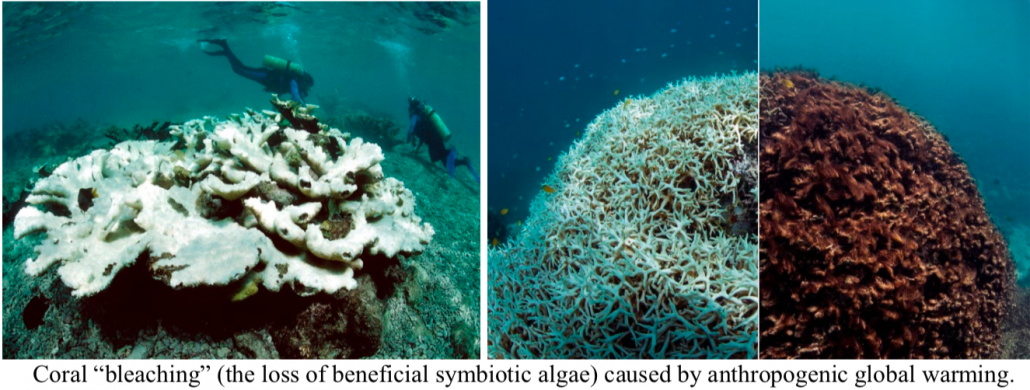
 This apocalypse is neither a distant peril nor a hypothetical threat to coral reefs. It is here; it is here now:
This apocalypse is neither a distant peril nor a hypothetical threat to coral reefs. It is here; it is here now:
- 66% of all GBR corals died within the last two years.
- World-wide, 50% of all corals have died in the last three decades, mostly from climate change and global warming.
- Coral reefs world-wide are not recovering.
- As a result of climate change, most coral reefs are predicted to be gone by 2040-2050, and with them the vast majority of species that constitute their extraordinary bio-diversity.
- Current rates of planetary warming are considered to be too rapid for coral adaptation.
- Even with the benefit of “assisted evolution,” whereby we attempt to create coral populations with elevated temperature-tolerances, the scale of the problem and the extremely high temperatures expected under any business-as-usual CO2 emissions scenario, are considered to be too great for coral survival.
Elevated CO2 levels affect the ocean in at least two physico-chemical ways:
- Rising temperatures (global warming)
- Falling pH (ocean acidification)
These two ocean modifiers have been referred to as the “Evil Twins” of climate change. Whereas global warming causes coral bleaching by killing the symbiotic algae, the solution of CO2 into oceanic waters causes the pH to fall as the ocean becomes more acidic. This future threat is of dire concern because, depending on the CO2 level, these acidic waters will either slow or prevent entirely the deposition of coral limestone skeletons. This phenomenon is analogous to the commonly understood etching effect of acid rain on limestone tombstones.
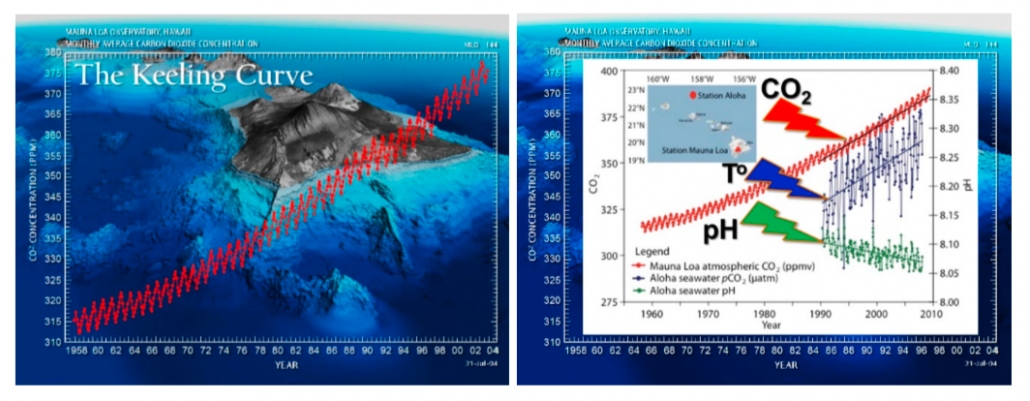 Both atmospheric and marine CO2 levels have been monitored in Hawaii. All measurements demonstrate, that as anthropogenic CO2 levels rise, air and water temperatures also rise, and oceanic pH falls.
Both atmospheric and marine CO2 levels have been monitored in Hawaii. All measurements demonstrate, that as anthropogenic CO2 levels rise, air and water temperatures also rise, and oceanic pH falls.
 Both global warming and ocean acidification are expected to destroy coral reefs as we know them by the end of this century. Caitlin SeaView@
Both global warming and ocean acidification are expected to destroy coral reefs as we know them by the end of this century. Caitlin SeaView@
I illustrate the extent of this global problem with two examples, one from the Florida Keys, the other from Discovery Bay, Jamaica.
Florida has lost half of all its living coral since the early1980s. These losses are continuing.
One example from Eastern Dry Rock Reef off of Key West can be seen below. These kinds of losses on shallow water reefs are common throughout the Florida Keys.
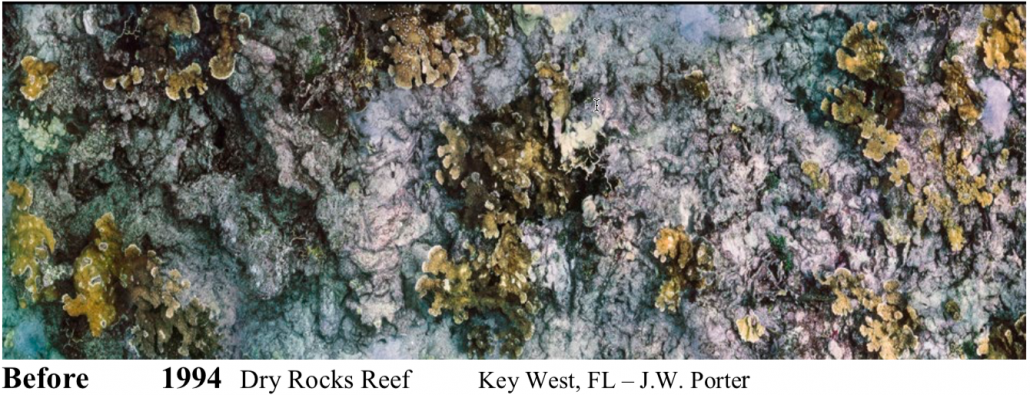
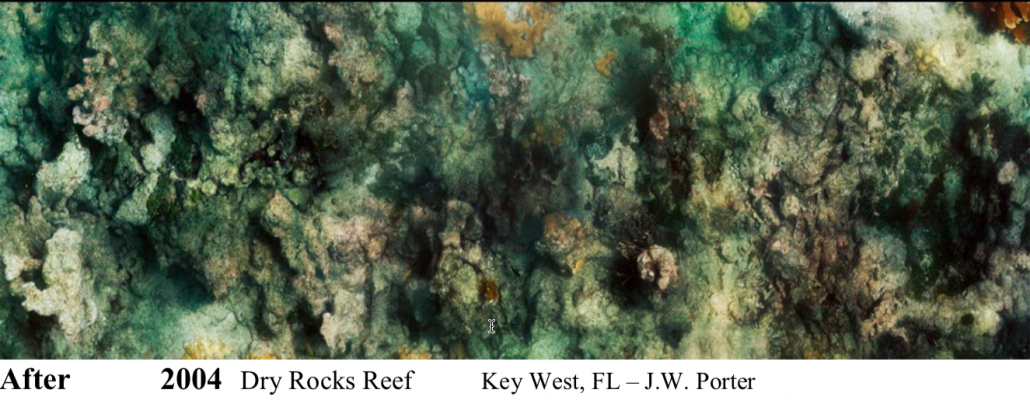
I addition to coral cover, reefs of the Florida Keys are also loosing species rapidly.
- With 43 reefs investigated, on average, Florida reefs lose 0.21 coral species per year.
- That translates to one species lost every 5 years.
- Alarmingly, this rate of species loss is the same both inside the NOAA Marine Sanctuary
Special Protected Areas and outside these carefully protected and carefully monitored no-
take zones (see graphs below). - 75% of all coral species in the Florida Keys are now found in fewer places than they were
at the beginning of the E.P.A. Coral Reef Evaluation and Monitoring Program, which
started in 1994. - One coral species, Isophyllastrea rigida has now gone extinct in the Florida Keys.
- Once among the commonest corals in the Caribbean, the iconic branching Elk Horn and Stag Horn corals have declined so much that they have been added to the Endangered Species List.
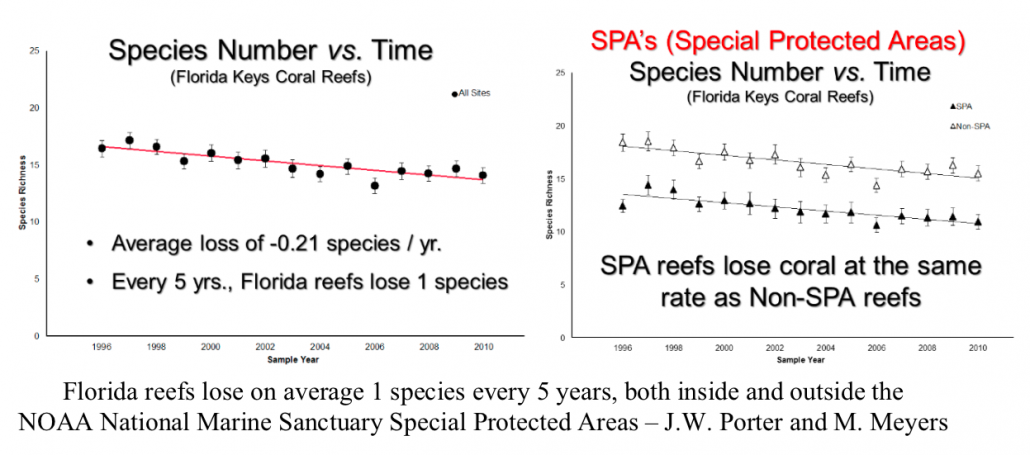
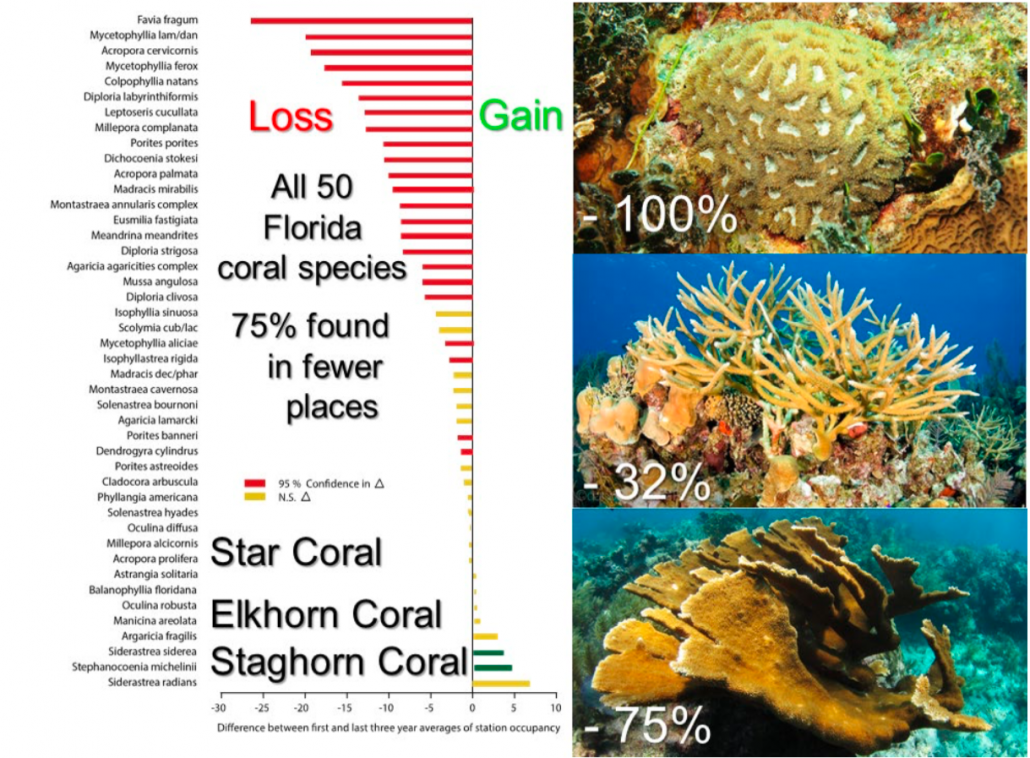
Similar losses occur throughout the Caribbean, as illustrated here with this pair of “before & after” photographs taken on shallow-water reefs in Discovery Bay, Jamaica. A combination of bleaching and hurricanes has degraded and converted vast regions along the north coast of Jamaica from coral reefs with high coral cover and high species diversity to rubble zones with low coral cover and low diversity.
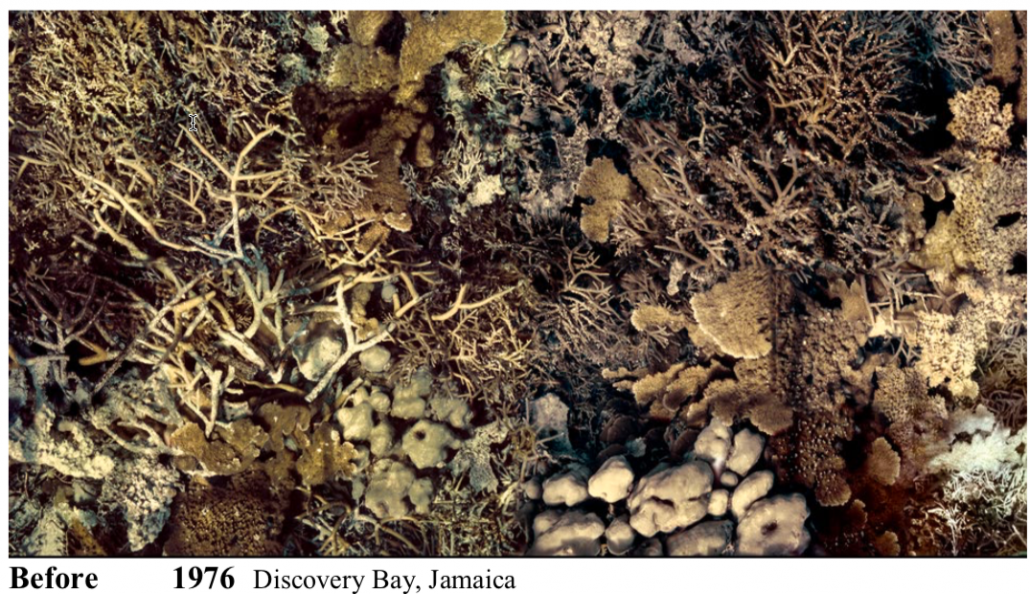
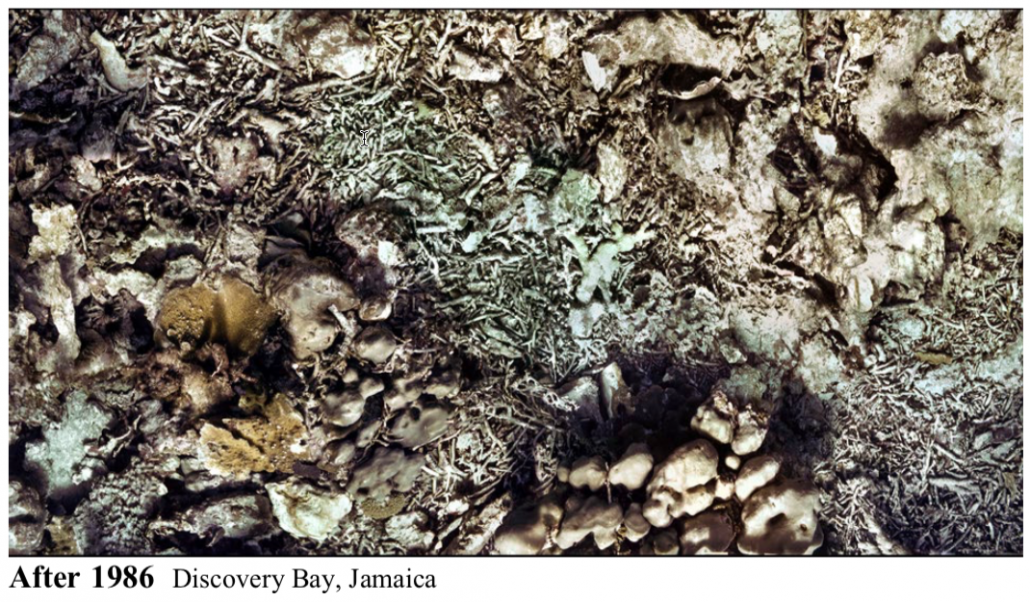
Finally, elevated CO2 levels in the Earth’s atmosphere will affect the ocean in at least one additional way. It will increase its physical size, causing:
- Sea Level rise, due to:
- Glacial melt and
- Thermal expansion
In tropical regions, sea-level rise will have devastating effects on coastal fishing and tourist communities that have grown up near coral reefs. Currently the “average-case” IPCC model predicts that sea levels will rise approximately 2 m by the end of this century. “Worst- case” models, however (which fit the data much better than the average-case models), put this S.L.R. value closer to 3 m. Regardless of which model is right, projecting sea level rise only to 2100 underplays the fact that by 2100, sea level will be rising nearly exponentially. Increases after 2100 will be much faster than before 2100.
 Given that sovereign nations like The Bahamas, Turks & Caicos, and the Cayman Islands are comprised exclusively of low-islands (and are therefore without mountainous interiors like Jamaica or Cuba), their existence is threatened by sea-level rise. These three island nations have a combined population of 475,000, all of whom are likely to become climate refugees sometime during the 22nd Century. Pacific island states like Kiribati are already beginning to transfer their population to nearby New Zealand. Other countries in the Caribbean, as well as coastal regions in Florida and elsewhere around the U.S. likewise face a diminution of their coast lines and a significant loss of their land areas (see maps below).
Given that sovereign nations like The Bahamas, Turks & Caicos, and the Cayman Islands are comprised exclusively of low-islands (and are therefore without mountainous interiors like Jamaica or Cuba), their existence is threatened by sea-level rise. These three island nations have a combined population of 475,000, all of whom are likely to become climate refugees sometime during the 22nd Century. Pacific island states like Kiribati are already beginning to transfer their population to nearby New Zealand. Other countries in the Caribbean, as well as coastal regions in Florida and elsewhere around the U.S. likewise face a diminution of their coast lines and a significant loss of their land areas (see maps below).
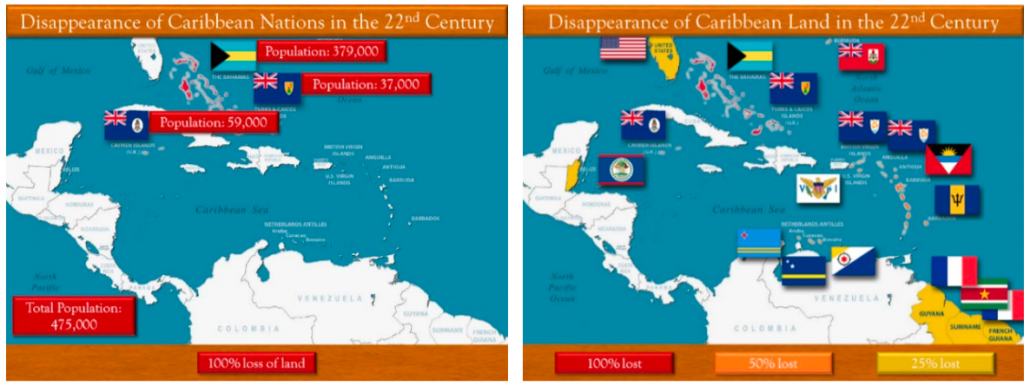
The IPBES report is an alarm bell. It tells us that to save the biological heritage of the Earth and the Ecosystem Services they provide, humankind must change its extractive and exploitative relationship to the natural world. We must stop maligning it and start preserving it.
For coral reefs, programs that reduce coastal-zone pollution are needed in addition to programs that reduce greenhouse gas emissions. We are in a race against time. We are losing.
I was asked to say something about what this House Committee could and should do in response to the IPBES report. All of the agencies you oversee, such as NSF, EPA, NOAA, NASA, etc., should be tasked (and funded!) to undertake broad-scale programs to address the planet’s impending biodiversity crisis.
In addition, I would like to suggest that perhaps the most important thing you could do would not cost anything. I recommend that each Member of the Committee on Science, Space, and Technology speak to at least one additional Member of Congress about what you have learned today. Tell them that the irrefutable evidence, from both land and sea, is that humankind is destroying species and ecosystems at an unsustainable rate. In addition to wreaking havoc on the natural world, these actions threaten our way of life, our civilization, and, potentially, even our own existence. The full weight of the U.S. government is necessary to address this planetary threat.
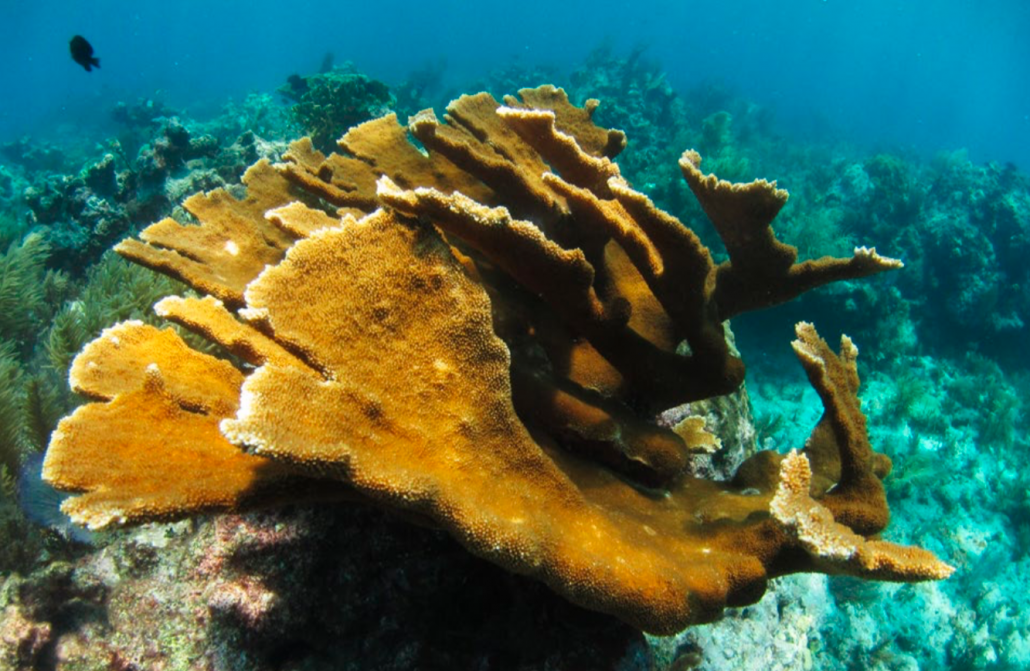

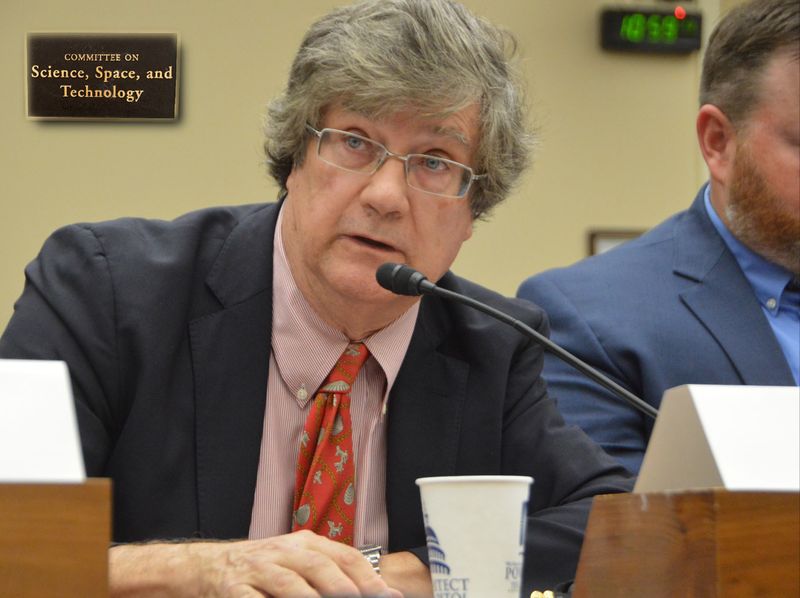
Hi Jim,
Thank you for giving this powerful testimony; and thank you for your work.
Since I’m not a scientist, I’ve been trying to do my part by lobbying Congress with the non-partisan group Citizens’ Climate Lobby (https://citizensclimatelobby.org).
I’d like to invite you, and anyone else who is interested, to join CCL’s Earth Day virtual celebration on Saturday, April 25 (details below).
Keep up the good work,
Chris
Chris Hoffman, J.E. ‘69
Please join Citizens’ Climate Lobby (CCL) to celebrate the 50th anniversary of Earth Day. Not all of us are able to focus on climate change right now. But for those who can, we’ll hear from climate leaders, learn about quick actions we can take to help climate change, and get trained. You can attend this virtual Earth Day event from home. Please join us, and (virtually) bring a friend!
Date And Time
Sat, April 25, 2020
1:00 PM – 4:00 PM EDT
Register here:
https://www.eventbrite.com/e/uniting-from-home-registration-101119077884